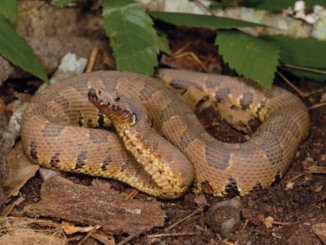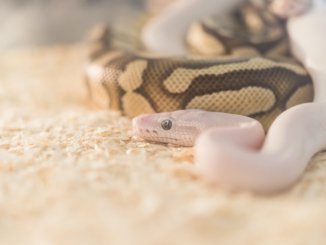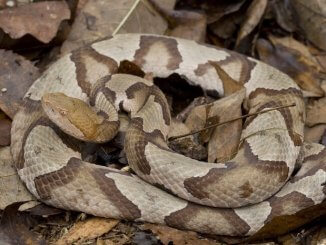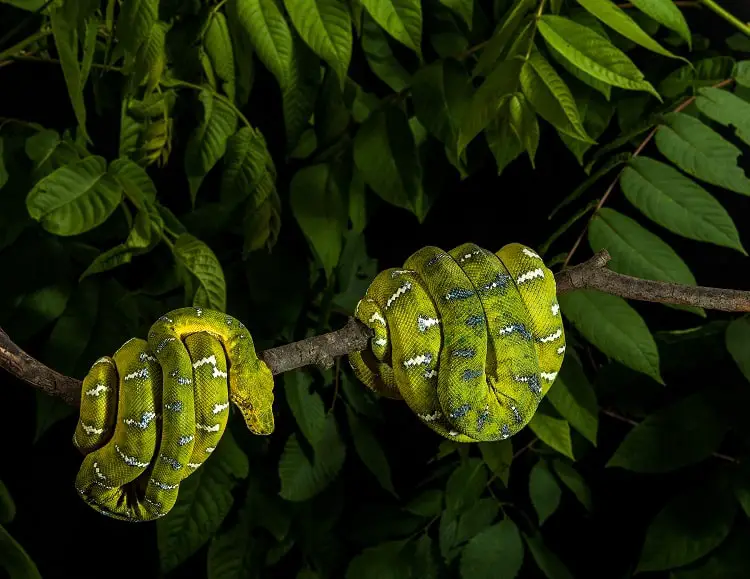
The emerald tree boa, as its name suggests, is a tree dweller. The snake spends most of its time high up in the foliage. It is a solitary snake found in the lowland tropical rainforests of the Amazonian and Guianan regions of South America.
Adult emerald tree boas can grow to over 2m in length. The males are usually significantly smaller than the females, and they have larger spurs. Both the female and male have highly developed front teeth, which are significantly larger than other non-venomous snakes.
Emerald Tree Boa Appearance
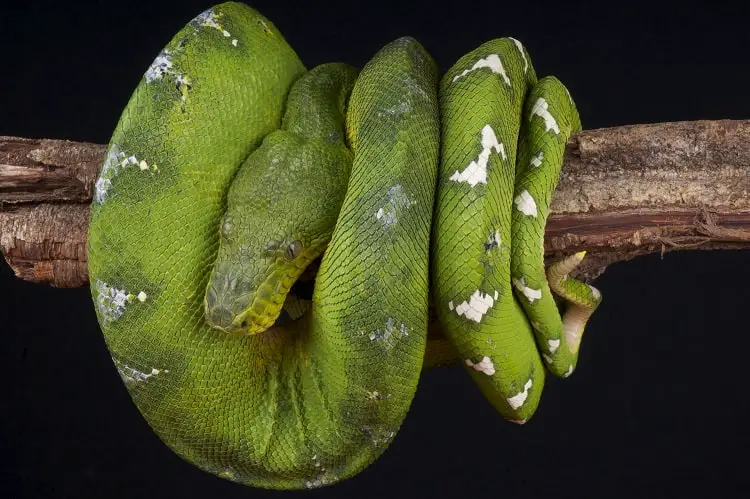
The name emerald comes from the snake’s exquisite green coloration. Most of these snakes have striking white markings that are found on the dorsal midline.
These markings are known as lightning bolts, and they go down the back and yellow belly. The snake’s bright coloration and its striking marking are quite distinctive among South American snakes.
However, these markings may be absent in some snakes. Instead of white, some have a black coloration on the dorsum.
Younger snakes have colors that range from brown to red before ontogenetic coloration sets. As they mature, the juvenile snakes will start turning emerald green to resemble their parents. As opposed to popular belief, there are no yellow juveniles in the emerald tree boa.
One interesting fact about these snakes is that they vary in size depending on location. For instance, snakes found around the Amazon River basin tend to grow the largest. Apart from that, they are way more docile than their Northern relatives.
Some specimens found in this area attained lengths of up to 7–9 feet. However, the average general length of emerald tree boas elsewhere is closer to 6 feet.
Emerald tree boas from the southern end of their range in Peru are also mostly darker in color. The majority of them have a single uninterrupted white dorsal line. On the other hand, the white markings on snakes found around Guyana and Surinam are quite variable.
You will also note that the snout scales on snakes from the Amazon Basin are a lot smaller than all the other counterparts.
There are also some hybrid forms between the Northern Shield Corallus caninus and the Amazon Basin with variable sizes, color patterns, and snout scale size.
Interestingly, this snake has an appearance that is very similar to the green tree python found in Southeast Asia and Australia. While these species are very distantly related, their head escalation and location of pits around the mouth are quite similar. Thus, this is a perfect example of convergent evolution.
Caring for the Emerald Tree Boa
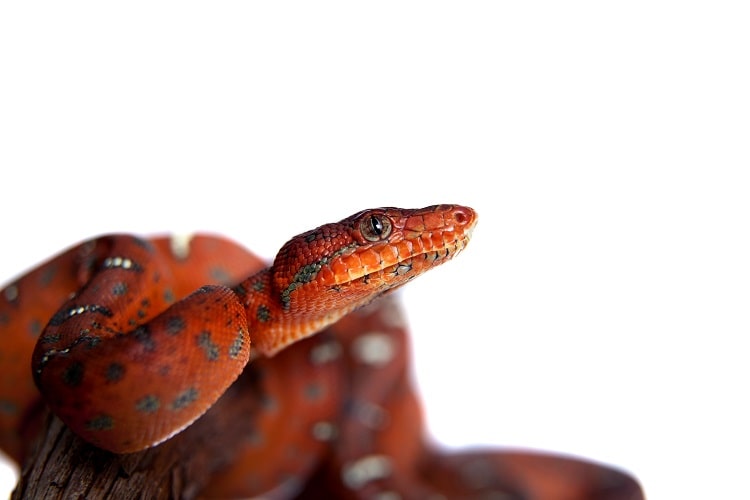
Caring for the emerald tree boa is not too difficult. The first thing you will need to set up if you are planning to care for an emerald tree boa is the habitat. Because of their tree-dwelling habits, emerald tree boa management can be rather complicated.
Ideally, the snake’s enclosure needs to be taller than it is wide or deep. You must also ensure that you secure the snake’s cage with very tight-fitting lids. For fresh air, ensure that the cage has two sides that are made of screen. The emerald tree boa is very sensitive to stale air hence fresh air is crucial at all times.
It is also advisable to have a simple cage design for ease of cleaning.
Substrate
The best substrate options include newspaper and butcher paper, among others. You can also use orchid bark and cypress mulch. The advantage of using newspaper and butcher paper is that they are cheaper options.
Apart from that, they are not difficult to clean, and the snake will not ingest them. The best option for higher humidity would be orchid bark.
Cypress is also good at holding moisture and maintaining high humidity levels. Both cypress and orchid bark is resistant to mold and fungus, and they also look nice. However, once you go with these two, you should approach feeding your snake differently.
Instead of placing food anywhere on the ground, you should use a container so that the snake won’t end up ingesting the substrate.
You should place several horizontal branches in the cage. These branches must have varying widths and be set at different heights. For easy to clean branches, you can use pieces of PVC pipe.
Temperature
The cage temperature for the emerald tree boa should be slightly lower than that of other neotropical boids.
Ideally, the daytime temperature must range from 24-28°C. You should also have a basking spot of 30°C. Nighttime temperatures must be dropped to 22-24°C. To provide heat, you can use lamps or heat emitters. However, these should never be underneath the cage.
Water and Humidity: The Key to Emerald Tree Boa Success
Emerald tree boas require very high levels of humidity. For proper shedding, you must ensure that the humidity levels stay at 80-90%. The snakes also need relatively high humidity for optimum respiratory function.
To maintain the humidity levels in your required range, you can use a water bowl, misting, and a humidifier.
These snakes are frequently rained on in their natural habitat, so they are quite used to having a lot of water around them. Therefore, it is very important to ensure that these snakes stay properly hydrated.
If the hydration levels are not high enough, the snake might end up with retained stools and large urates. Another result of improper hydration is incomplete sheds and potentially stuck embryos.
Water bowls must be placed higher in the enclosure, ideally next to perches. You should also change the water frequently. To stimulate drinking, it is advisable to replace the water at least once a week.
These snakes can sense freshwater, so once you replace the water, they will likely drink it.
Enclosure Design and Size for Emerald Tree Boas
Breeding enclosures for adult emerald tree boas should measure about 33 inches long, 28 inches deep, and 28 inches tall. You can use extruded PVC hollow core material to make the enclosure. These materials are ideal for maintaining temperatures.
For the doors, most people use tempered glass with magnetic latches for easy operation. To augment humidity and create a somewhat natural setup, you can include some planters in the cages.
The juvenile snakes should be kept in smaller cages that resemble adult enclosures. However, these cages should be without plants. For newborns, you will need habitat system racks made from Rubbermaid polycarbonate clear tubs.
Ideally, these should measure about 18 inches long by 12 inches deep by 9 inches tall. You must position the perches in the smaller cages so that the juvenile snakes can easily reach the bottom of the tub for water and feeding.
To maintain a heat gradient, you can embed a heat tap in the back half of the tubs. The position of the water bowl in relation to the heat source will also help to maintain humidity.
If you want to create an enclosure for viewing for the adult emerald tree boa, the measurements should be about three feet long, two feet tall, and two feet deep.
However, you must avoid having clear sides in the display enclosure as this will make the snake feel insecure. You can only have an all-glass front and live or artificial plants. Artificial plants are recommended to provide some cover for the snake to hide.
Feeding
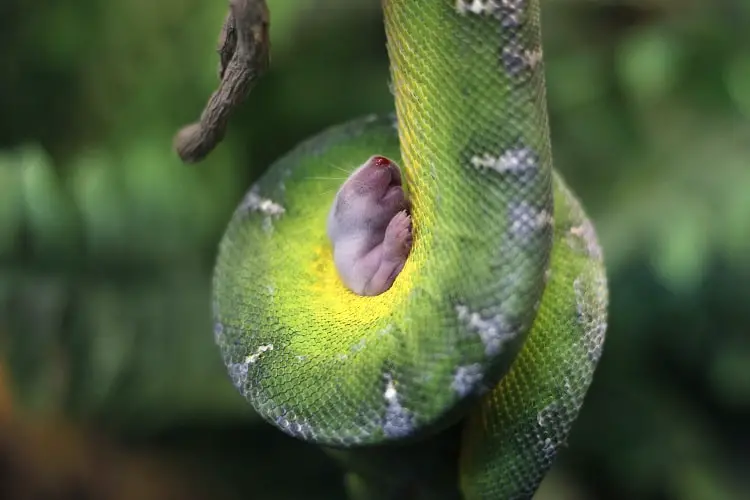
The emerald tree boa is a carnivore. The snake eats birds and small mammals. Its diet comprises rats, bats, squirrels, and lizards.
Younger snakes can also eat small reptiles and amphibians. To maintain the snake in good health, you should feed it once every two weeks with mice.
Lifespan & Health Concerns
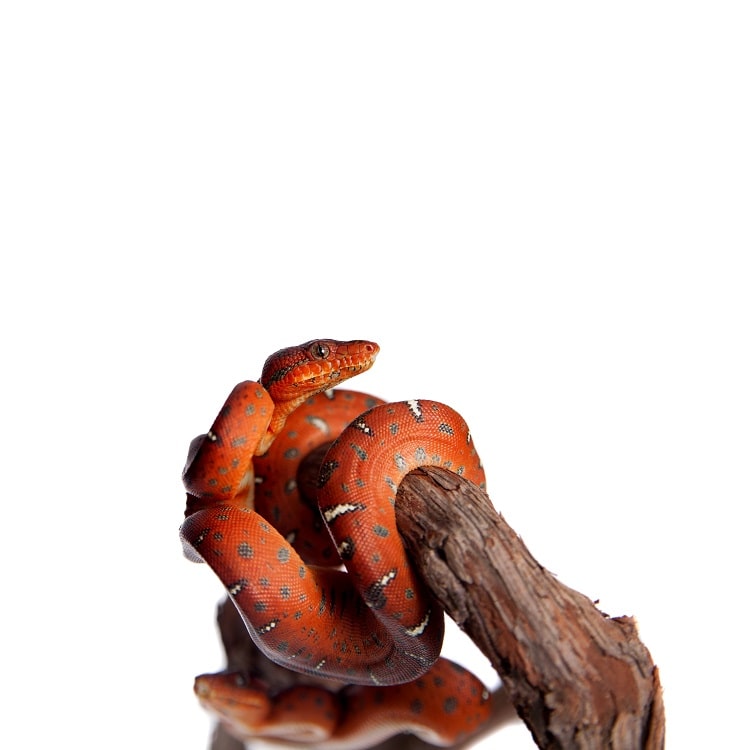
The life expectancy of an emerald tree boa in captivity is about 20years. However, their lifespan in their natural habitat is a lot shorter. Emerald tree boas can live for up to 15 years in the wild.
Stool Retention
Stool retention is one of the more common problems with emerald tree boas. The snakes can retain their stool for long periods, and this causes pressure on the cloaca.
Some people believe that in the wild, these snakes mostly defecate when it’s raining. The idea is to have the stool washed away by the rain so that the scent doesn’t attract predators.
To simulate this behavior, you can design your rain chamber. You can use this to stimulate your snake’s bowel movement and help with hydration by placing it in a rain chamber.
To make the snake’s visit to the rain chamber more convenient, you can install removable perches in the enclosure.
Although creating a rain chamber for your emerald tree boa is not mandatory, it is a necessary tool to maintain your snake in good health.
Usually, the snake will defecate within a few minutes of being placed inside an active rain chamber. Experienced keepers usually cycle the snakes through the chamber at least once a month. You can also do it when needed.
For instance, placing it in a rain chamber will help if the snake is stuck while shedding. It is crucial to ensure that the rain chamber has clean water at all times.
The snake would drink some water when you place it in the chamber, so it would be best if it didn’t drink recycled dirty water.
Diseases of the Emerald Tree Boa
The emerald tree boa can get stressed easily. This makes it susceptible to several infections, diseases, and opportunistic pathogens. Here are some of the common conditions that affect this snake.
Respiratory
The emerald tree boa is greatly affected by very low temperatures and humidity. These conditions make the snake susceptible to respiratory infections.
Some of the symptoms of respiratory infections in an emerald tree boa include wheezing, difficulty breathing, too much mucus in the mouth, and a nasal discharge.
The first step in managing this condition is doing a bacterial and fungal culture. Sensitivity tests will then help to come up with the correct antibiotic choice.
You should also make the appropriate husbandry changes to fully recover the snake and ensure the condition doesn’t come back. Chlamydiosis is also a common condition that affects emerald tree boas.
Digestive
Several gastrointestinal problems affect emerald tree boas. These conditions include anorexia, diarrhea, constipation, and regurgitation.
You will find that imported snakes are quite susceptible to going down with digestive problems. This is because they are often stressed a lot, and they usually carry a heavy parasite load which makes them anorexic.
Emerald tree boas are highly susceptible to Cryptosporidium infections. These infections present as chronic regurgitation. Another common factor that causes digestive problems is dehydration.
Dehydration can lead to several problems, the chief being constipation. Because of lack of water, their stool tends to dry out and become quite hard to pass. Constipation can also be the result of overfeeding.
Neurologic
Boids are susceptible to a retrovirus that causes inclusion body disease. This viral disease affects the nervous system, and it also causes regurgitation. Apart from that, research also shows that it is capable of causing secondary pneumonia.
A biopsy of the esophageal tonsils, liver, and kidney can be taken to diagnose this condition, and the vet will also do a complete blood count. Unfortunately, once a snake is infected, it will not recover. Therefore, all infected snakes are euthanized.
Skin
One of the most common skin conditions in emerald tree boas is dysecdysis. This condition occurs as a result of low humidity. However, it may also be caused by a mite infestation, poor nutrition, and improper handling.
If your emerald tree boa comes down with dysecdysis, it is recommended to soak it in tepid (lukewarm) water for half an hour. You can then rub it gently with a towel to detach pieces of the skin.
If the snake retains eye caps, it must be properly removed by someone adequately trained to avoid permanent injury to the cornea.
Behavior
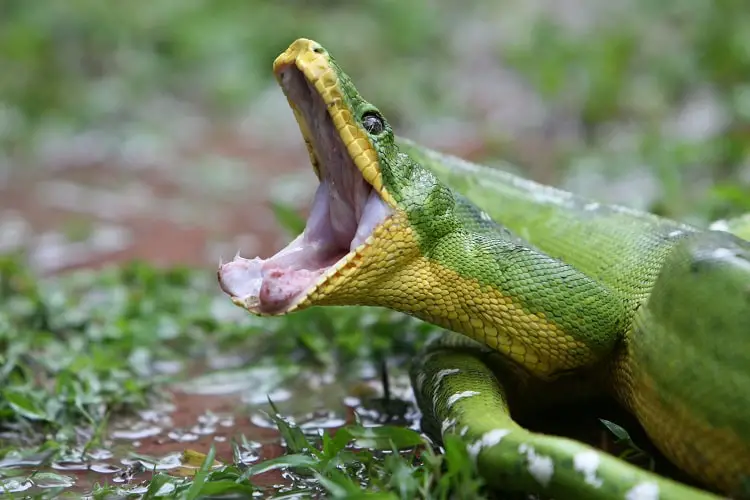
Emerald tree boas are ambush hunters. They hunt at night and often wait in the branches prepared to attack unsuspecting small rodents that move around beneath them.
Communication and Perception
Emerald tree boas detect their prey through sight. They also have some infrared heat receptors positioned on the labial scales. These heat-detector pits are crucial for detecting prey during the night.
Like most snakes, the emerald tree boa also uses its tongue and the vomeronasal organs to detect chemical cues in the wind. Apart from that, they can also detect vibrations. These snakes do not communicate much.
They are a solitary species, and their only interactions are with a mate or with prey. However, if the males get too close to each other, some aggressive behavior might be displayed.
If males are kept together in an enclosure, they will usually fight if a female is present. The males will mount, chase, and writhe their bodies until one of them gives up.
The winner will then chase the other snake and constrict its neck with the end of its body.
Breeding
The emerald tree boa’s breeding season lasts from April to July. The females will start mating as soon as they reach 4 to 5 years old, and the males become sexually mature at 3 to 4 years old.
These snakes only breed once every two years. They produce as many as 20 babies following a six to seven-month gestation period. Unlike other snakes, their eggs hatch internally, and the young will come out alive.
Juvenile snakes can climb up and start fending for themselves soon after birth. They are remarkable in that they don’t need any assistance from their parents.
Because of their reproductive behavior, emerald tree boas are known as ‘live bearing’ snakes. However, unlike mammals, there will be no placental attachment between the emerald boa and its young.
All that’s there is a gelatinous sack that contains each unborn snake.
The snake is thought to be ready to mate and lay eggs any time of the year. However, most of the mating activities take place between November through January in the northern hemisphere.
They also require a daytime temperature of 24°C (75°F) and a nighttime temperature drop to 17°C for them to start mating.
When the female snake is ovulating, you will notice a lump in the middle part of its body. The lump typically lasts between 8-24 hours.
As soon as the female is done ovulating, it will go through what is known as a post-ovulation shed. The shed will be completed in 20-30 days post-ovulation.
Pregnant emerald tree boas usually like basking extensively at temperatures of 30-32°C. These snakes will give birth about 100-110 days post ovulation.
Safety
There are no documented human deaths from emerald tree boa bites. These snakes are not venomous. Therefore their bite will not result in any serious problems. Apart from that, they are quite small.
Hence their constriction is not a threat to humans as well. They are only powerful enough to constrict their prey which comprises birds and small mammals.
Price/Cost
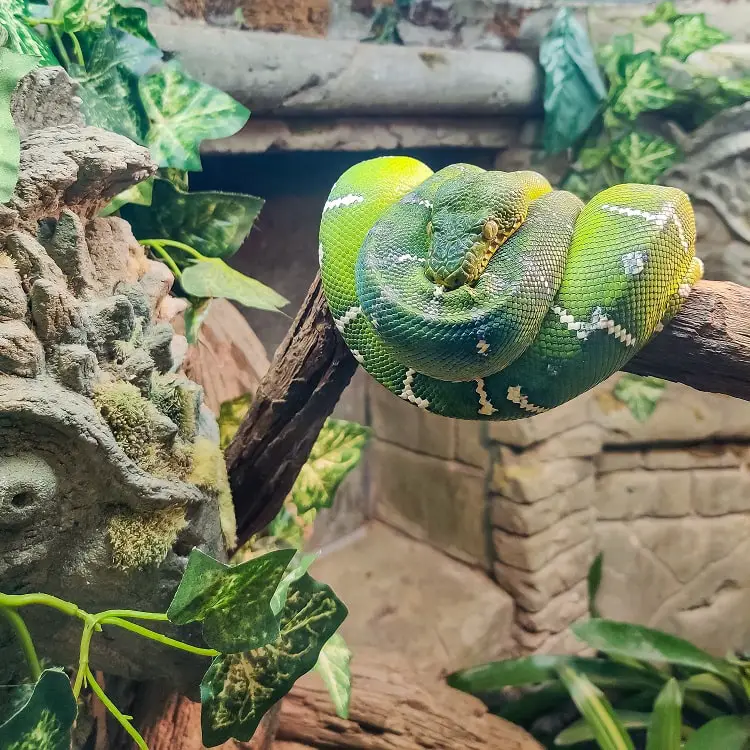
Young emerald tree boas can be bought online for about $300 to $400. You can request a male or female snake for your order. However, most people who sell these snakes are not able to guarantee sex.
You will also be charged a fee for delivery to your doorstep.
Therefore, before you order the snake, it is important to read the shipping information and determine whether the shop ships to your location.
Facts
- Common Name – Emerald tree boa
- Scientific Name – Corallus Caninus
- Family Name – Boas
- Reproductive season – April-July
- Pregnancy duration – 6-7 months
- Number of snakelets – 20
- Genus Name – Neotropical tree boas
- Range – Lowland tropical rainforests in the Amazonian and Guianan regions of South America.
- Adult Size – 6 feet (1.8 m) in length.
- Lifespan – 20 years in captivity and 15 in the wild
- Similar Species/Popular Alternatives – Green tree python
Summary
The emerald tree boa was discovered by Carolus Linnaeus. The snake is emerald green in color, and it has white stripes and a yellow underside.
Like most reptiles, the emerald tree boa is cold-blooded. Its head has relatively large bulges on either side at the back.
These bulges give the emerald tree boas head a heart shape. The emerald tree boa has powerful fangs, making it easy for the snake to capture its prey.
However, these fangs are not used to deliver venom as the snake is non-venomous. The snake also has a very strong prehensile tail which it uses during fighting and hunting.
In general, emerald tree boas are not too difficult to keep. However, you have to make sure that you get the maintenance requirements right so you don’t have any problems.

